Blue-tongued skink facts for kids
Quick facts for kids Blue-tongued skinks |
|
|---|---|
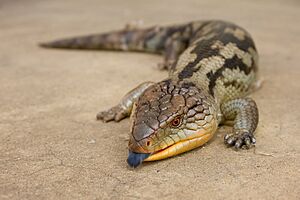 |
|
| Blotched blue-tongued skink (Tiliqua nigrolutea) | |
| Scientific classification |
|
| Kingdom: | Animalia |
| Phylum: | Chordata |
| Class: | Reptilia |
| Order: | Squamata |
| Family: | Scincidae |
| Subfamily: | Egerniinae |
| Genus: | Tiliqua Gray, 1825 |
| Species | |
|
8 extant, see text. |
|
| Synonyms | |
|
Trachydosaurus |
|
Blue-tongued skinks are a group of lizards found mostly in Australia. They are known for their bright blue tongues! These lizards are some of the biggest in the skink family. People often call them "blue-tongued lizards," "blue-tongues," or even "blueys." In Indonesia, they are sometimes called "panana."
When a blue-tongued skink feels scared or threatened, it will stick out its big blue tongue. This is a warning sign to scare away enemies. The color of the tongue can change depending on how much danger the skink feels. Their tongues can also make a thick, sticky slime to help them catch food. Blue-tongues are usually quite shy and move slower than other lizards because they have shorter legs.
Contents
What Makes Blue-Tongued Skinks Special?
Their Amazing Blue Tongue
The most famous thing about these lizards is their bright blue tongue. When a blue-tongue feels threatened, it opens its mouth wide and shows off its tongue. This sudden flash of blue can surprise a predator and give the skink time to escape. The color can be very intense, depending on how scared the skink is.
Where Blue-Tongues Live
Most blue-tongued skinks live in Australia. However, one type, the Indonesian blue-tongued skink (Tiliqua gigas), lives in New Guinea and some islands in Indonesia. Another kind, the Tanimbar blue-tongued skink, is found on smaller Indonesian islands. The Blotched blue-tongued skink (Tiliqua nigrolutea) is the only species found in Tasmania.
What Do Blue-Tongued Skinks Eat?
Most blue-tongued skinks are active during the day. They search for food on the ground. They are omnivores, which means they eat both plants and animals. Their diet includes many different things like insects, snails, flowers, fruits, and berries.
The pygmy blue-tongue skink is a bit different. It mostly waits to ambush its prey. It eats arthropods that live on the ground.
All blue-tongued skinks give birth to live babies, instead of laying eggs. The number of babies can vary a lot. Pygmy blue-tongues and shinglebacks might have 1 to 4 babies. Other types, like the eastern and northern blue-tongues, can have 5 to 24 babies at once!
Types of Blue-Tongued Skinks
There are several different kinds of blue-tongued skinks. Here are some of the main ones:
| Common Name | Scientific Name | Picture | Subspecies (types within the species) |
|---|---|---|---|
| Adelaide pygmy blue-tongue skink | T. adelaidensis |  |
|
| Indonesian blue-tongued skink | T. gigas |  |
T. g. gigas, Giant blue-tongued skink; T. g. evanescens, Merauke blue-tongued skink; T. g. keyensis, Key Island blue-tongued skink |
| Centralian blue-tongued skink | T. multifasciata |  |
|
| Blotched blue-tongued skink | T. nigrolutea | 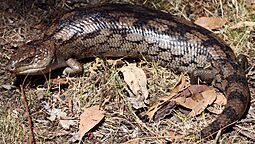 |
|
| Western blue-tongued skink | T. occipitalis | 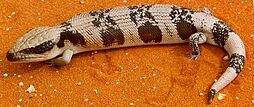 |
|
| Shingleback, bobtail | T. rugosa |  |
T. r. aspera, Eastern shingleback; T. r. konowi, Rottnest Island bobtail; T. r. palarra, Shark Bay bobtail; T. r. rugosa, Common shingleback, bobtail |
| Common blue-tongued skink | T. scincoides | 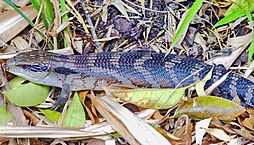 |
T. s. chimaerea, Tanimbar blue-tongued skink; T. s. intermedia, Northern blue-tongued skink; T. s. scincoides, Eastern blue-tongued skink |
| Irian Jaya blue-tongued skink | Tiliqua sp. | 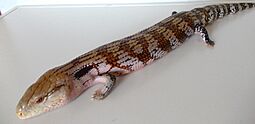 |
Ancient Blue-Tongues
Scientists have found fossils of blue-tongued skinks that lived a very long time ago. One of the largest known species was T. frangens. It lived during the Pliocene and Pleistocene periods in Australia. This ancient skink was twice the size of today's shingleback skink!
Blue-Tongues as Pets
Blue-tongued skinks are generally calm and gentle. They can be easily tamed, which makes them good reptile pets for beginners. Even though they are not aggressive, they have strong jaws and teeth. A bite from a skink can be painful, so it's always best not to scare or bother them. If they feel threatened, they might bite. These amazing lizards can live for 20 years or even longer when cared for properly!
Images for kids
See also
 In Spanish: Lagartos de Lengua Azulada para niños
In Spanish: Lagartos de Lengua Azulada para niños


